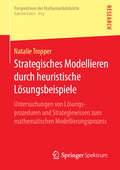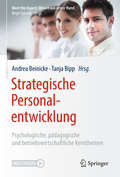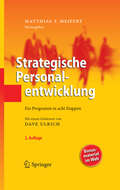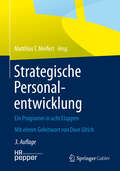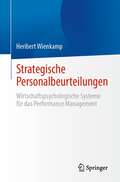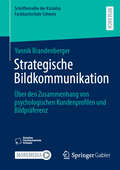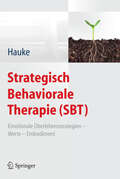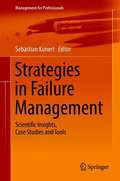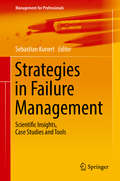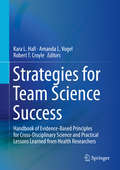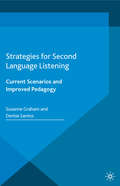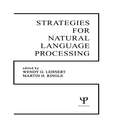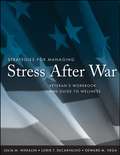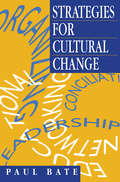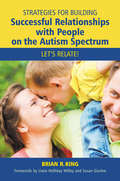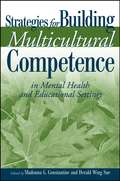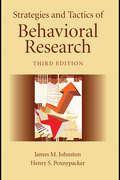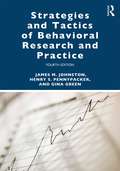- Table View
- List View
Strategisches Qualitätsmanagement in der Hochschullehre: Theoriegeleitete Workshops für Lehrende zur Förderung kompetenzorientierter Lehre
by Immanuel UlrichWas ist gute Lehre? Wie kann man Hochschuldozierende wissenschaftlich fundiert weiterbilden? Immanuel Ulrich konzeptionierte eine wissenschaftliche Weiterbildung und erprobte sie in der Praxis: 79 Lehrende mit ihren 3.183 Studierenden aus geistes-, sozial- und naturwissenschaftlichen Fachbereichen der Freien Universität nahmen an der anderthalbjährigen Studie teil. Das Wissen und die Fähigkeiten der Lehrenden stiegen konsistent durch die Intervention. Die weitergebildeten Dozierenden erhielten bessere Lehrevaluationsergebnisse.
Strategisches Modellieren durch heuristische Lösungsbeispiele: Untersuchungen von Lösungsprozeduren und Strategiewissen zum mathematischen Modellierungsprozess (Perspektiven der Mathematikdidaktik)
by Natalie TropperDie Vermittlung mathematischer Modellierungskompetenz stellt ein zentrales Ziel kompetenzorientierten Mathematikunterrichts dar. Da bislang nur vereinzelt spezifische Vermittlungsaspekte zur Förderung dieser Kompetenz untersucht wurden, geht Natalie Tropper dieser Thematik im Rahmen einer qualitativ angelegten Untersuchung nach. Sie betrachtet die Einflüsse strategiebetonter heuristischer Lösungsbeispiele auf die Modellierungsprozesse und das modellierungsbezogene Strategiewissen von Schülerinnen und Schülern. Die Ergebnisse ihrer empirischen Studie zeigen das Potential des gewählten Instruktionsmaterials zur Unterstützung modellierungsbezogener Lernprozesse auf und legen zugleich Implikationen für dessen unterrichtliche Einbettung nahe.
Strategische Personalentwicklung in der Praxis: Instrumente, Erfolgsmodelle, Checklisten, Praxisbeispiele
by Christine WegerichChristine Wegerich liefert eine umfassende und aktuelle Übersicht über die gängigen Methoden und Instrumente der strategischen Personalentwicklung. Unternehmen sind nur dann erfolgreich, wenn sie ihre Personalentwicklung auf die strategischen Ziele in ihren Märkten ausrichten. Die Autorin beschreibt den gesamten Personalentwicklungsprozess und präsentiert aktuelle Beispiele aus der Praxis. Checklisten und Expertenaussagen zeigen bewährte sowie innovative Konzepte und geben konkrete Handlungsempfehlungen für die Planung, Umsetzung und Evaluation.Für die 3. Auflage ist das Buch komplett aktualisiert und erweitert worden. Beispiele für den erfolgreichen Einsatz strategischer Personalentwicklung – unter anderem: AOK, Commerzbank, Novartis und TRUMPF – sowie neue Konzepte der beruflichen Erstausbildung werden detailliert vorgestellt.
Strategische Personalentwicklung: Psychologische, pädagogische und betriebswirtschaftliche Kernthemen (Meet the Expert: Wissen aus erster Hand)
by Andrea Beinicke Tanja BippIn diesem Buch beantworten führende Expertinnen und Experten aus den Bereichen der Psychologie, Erwachsenenbildung und Betriebswirtschaftslehre praxisbezogene relevante Fragen zur Thematik der beruflichen Weiterbildung in der heutigen Arbeitswelt. Sie erfahren mehr zum Thema Personalentwicklung im Wandel der Zeit, verschiedene Weiterbildungssettings und wie Weiterbildungsserfolge sichergestellt werden können. Sie erhalten auch wissenschaftlich fundierte Erkenntnisse über Coaching und Mentoring und weitere Kernthemen wie: - Wie wirkt sich die alternde Arbeitsgesellschaft auf die betriebliche Weiterbildung aus?- Wie stellt man den Erfolg von Trainingsmaßnahmen im Arbeitsalltag sicher, so dass sich Investitionen in solche Maßnahmen lohnen? - Wie können Führungskräfte ihre Mitarbeitenden dazu befähigen, notwendige Kompetenzen für das heutige und zukünftige Arbeitsleben zu entwickeln? - Ist Coaching von Mitarbeitenden effektiv oder können auch negative Effekte auftreten?Dieses Buch richtet sich an Professionals aus der Praxis, die im Bereich Human Resource Development tätig sind wie Personalverantwortliche, Personalentwickler, Personalleiter sowie Mitarbeitende aus Weiterbildungseinrichtungen. Aber auch Studierende, Lehrende, und Wissenschaftler und alle, die Interesse haben, sich mit aktuellen und zukunftsweisenden Fragen der Personalentwicklung zu beschäftigen, sind zur Lektüre eingeladen.
Strategische Personalentwicklung: Psychologische, pädagogische und betriebswirtschaftliche Kernthemen (Meet the Expert: Wissen aus erster Hand)
by Andrea Beinicke Tanja BippIn diesem Buch beantworten führende Expertinnen und Experten aus den Bereichen der Psychologie, Erwachsenenbildung und Betriebswirtschaftslehre praxisbezogene relevante Fragen zur Thematik der beruflichen Weiterbildung in der heutigen Arbeitswelt.Sie erfahren mehr zum Thema Personalentwicklung im Wandel der Zeit, verschiedene Weiterbildungssettings und wie Weiterbildungsserfolge sichergestellt werden können. Sie erhalten auch wissenschaftlich fundierte Erkenntnisse über Coaching und Mentoring und weitere Kernthemen wie:Wie wirkt sich die alternde Arbeitsgesellschaft auf die betriebliche Weiterbildung aus?Wie stellt man den Erfolg von Trainingsmaßnahmen im Arbeitsalltag sicher?Wie können Führungskräfte ihre Mitarbeitenden dazu befähigen, notwendige Kompetenzen für das heutige und zukünftige Arbeitsleben zu entwickeln?Ist Coaching von Mitarbeitern effektiv oder können negative Effekte auftreten?Dieses Buch richtet sich an Professionals aus der Praxis, die im Bereich Human Resource Development tätig sind wie Personalverantwortliche, Personalentwickler, Personalleiter sowie Mitarbeitende aus Weiterbildungseinrichtungen. Aber auch Studierende, Lehrende, und Wissenschaftler und alle, die Interesse haben, sich mit aktuellen und zukunftsweisenden Fragen der Personalentwicklung zu beschäftigen, sind zur Lektüre eingeladen.
Strategische Personalentwicklung: Ein Programm in acht Etappen
by Matthias T. MeifertPersonalentwickler in deutschen Unternehmen sehen sich einem starken Rechtfertigungsdruck ausgesetzt. Es geht dabei im Kern um die Frage, inwieweit die Personalentwicklung einen Wertschöpfungsbeitrag für das Unternehmen erbringt. Die Antwort darauf ist eine konsequente Orientierung aller Instrumente der Personalentwicklung an der Unternehmensstrategie. Das Buch stellt ein Programm in acht Etappen vor, mit dem eine strategische Personalentwicklung erfolgreich umgesetzt werden kann. Für die Neuauflage wurde der Anwendungsbezug weiter erhöht.
Strategische Personalentwicklung: Ein Programm in acht Etappen
by Dave Ulrich"In Zeiten, in denen nahezu jedes Unternehmen vor neuen und unerwarteten Herausforderungen steht, denkt wohl jeder, der in verantwortungsvoller Position tätig ist, über die Zukunft nach. Als Konsequenz entwickelt sich nicht nur in den großen, sondern zunehmend auch in mittleren und kleineren Unternehmen strategische Planung. Was aber helfen die überzeugendsten strategischen Konzepte, wenn den Mitarbeiterinnen und Mitarbeitern die Bereitschaft und die Fähigkeit fehlen, einen Plan umzusetzen? Es gilt also, die Mitarbeiter zu entwickeln, und zwar nicht für das, was heute ansteht, sondern für das, was morgen gefordert wird. Strategische Personalentwicklung wird daher für den künftigen Unternehmenserfolg zur kritischen Größe. Was dabei grundsätzlich zu bedenken und konkret zu tun ist, zeigt dieses von Matthias T. Meifert herausgegebene Werk. In einer schönen Systematik werden acht Etappen der Personalentwicklung dargestellt, erfolgskritische Faktoren beschrieben sowie Hinweise für die alltägliche strategische Personalentwicklungsarbeit im Unternehmen geschildertgegeben. (...) Wer also wissen möchte, was man unter strategischer Personalentwicklung versteht und dann nach konkreten Hinweisen sucht, wie er dieses Wissen im Unternehmen auch umsetzen kann, für den ist dieses Buch nahezu unverzichtbar." Prof. Dr. Dr. h. c. Lutz von Rosenstiel, Lehrstuhl für Organisations- und Wirtschaftspsychologie, Ludwig-Maximilians-Universität München
Strategische Personalbeurteilungen: Wirtschaftspsychologische Systeme für das Performance Management
by Heribert WienkampStrategische Personalbeurteilungen konzentrieren sich zum einen auf die Personen, die sich bereits im Unternehmen befinden und „Geld kosten“, zum anderen zielen sie im Rahmen des Performance Managements darauf ab, über eine Vielzahl karrierefördernder Maßnahmen die Beschäftigten nach Möglichkeit bis zum Ruhestand „bei Laune zu halten“ und an die Firma zu binden. Nur dann ist eine Amortisation aller Investitionen in die Personalentwicklung und die Erzielung einer maximalen „Bildungs-Rendite“ gewährleistet.Um die personalstrategischen Ziele zu erreichen, empfiehlt es sich, einerseits den Kommunikations- und Feedbackprozess durch eine „jobspezifische“ Mitarbeiterbeurteilung zu unterstützen und zu formalisieren, andererseits diesen Prozess der Mitarbeiterfürsorge und Beziehungspflege durch die Vorgesetzten von der Leistungshonorierung und der Karriereentwicklung als Aktivitäten des Personalmanagements zu trennen. Neben der Diskussion von sonstigen beurteilungsrelevanten Themen (z.B. Beurteilungssysteme oder Schulungen) soll auch der Frage nachgegangen werden, wie dem „Lernen und Entwickeln“ aus der Balance Score Card durch Mitarbeiterfeedback im Rahmen der Personalbeurteilung bei der Strategieumsetzung und Unternehmensentwicklung geholfen werden kann. Zum Inhalt Strategiebewertung mit Hilfe der Rückmeldung aus den Beurteilungsgesprächen,Vor- und Nachteile einer Differenzierung zwischen Mitarbeiter-Feedback bezogen auf die aktuelle Tätigkeit und karrierefördernden Maßnahmen, „Lernen und Entwickeln“ aus der Perspektive der Balance Score Card (BSC), Strategieumsetzung und Strategiebewertung, Details zum Beurteilungsgespräch und die Bedeutung der Selbstbeurteilung als Vorbereitung auf die Mitarbeiterbeurteilung …und vieles mehr.
Strategische Bildkommunikation: Über den Zusammenhang von psychologischen Kundenprofilen und Bildpräferenz (Schriftenreihe der Kalaidos Fachhochschule Schweiz)
by Yannik BrandenbergerIn einer sich rasant verändernden Marketinglandschaft wird die Bedeutung einer authentischen Verbindung zwischen Unternehmen und Konsumenten immer dringlicher. Statt mit Inhalten zu überfluten, liegt die Herausforderung darin, durch gezielte visuelle Kommunikation eine tiefere Bindung aufzubauen. Diese Herausforderung wird besonders in der fehlenden Anpassung von Bildern an die psychologischen Profile der Zielgruppe deutlich, für die bisher kein empirisch validiertes Modell existiert. In diesem Buch wird ein tiefer Einblick in den Zusammenhang zwischen psychologischen Kundenprofilen und Bildpräferenzen durch die Untersuchung und Weiterentwicklung des EIC-Modells gewonnen. Die empirischen Ergebnisse, gewonnen aus einer Studie mit 95 Teilnehmenden, bestätigen diese Verbindung und eröffnen neue Perspektiven für die strategische Bildkommunikation. Als Resultat dieser Forschung präsentiert sich das ICS-Modell – ein Instrument, das Fotograf*innen und Marketingexpert*innen befähigt, die Bildkommunikation gezielt auf Zielgruppen auszurichten. Dieses Buch bietet nicht nur einen Einblick in die theoretischen Grundlagen, es regt auch dazu an, wie diese Erkenntnisse in der Praxis für eine wirkungsvolle visuelle Kommunikation genutzt werden können.
Strategisch-systemische Aspekte der Verhaltenstherapie: Eine praxisbezogene Systematik in ihren historisch-autobiografischen Bezügen
by Iver HandModerne, integrative Ergänzung aktueller Lehrbücher: Prof. Dr. med. Iver Hand leitete von 1976 bis 2006 den Bereich Verhaltenstherapie an der Klinik f. Psychiatrie und Psychotherapie des Universitätsklinikums Hamburg Eppendorf. Seine (Be-)Handlungsstrategie betont die intrapsychische und interaktionelle Funktionsdiagnostik. Sie klärt die Motivation der Patienten zur Veränderung und zugleich deren mögliche Auswirkungen auf das engere soziale Umfeld. Das Verfahren – inklusive zahlreicher praxisrelevanter Fallbeispiele – trägt dazu bei, die Symptom- oder reine Ursachentherapie bzw. die Kombination beider Therapien miteinander zu verbessern.
Strategisch Behaviorale Therapie (SBT): Emotionale Überlebensstrategien – Werte – Embodiment
by Gernot HaukeDie Strategisch Behaviorale Therapie (SBT) betrachtet die Befriedigung psychologischer Grundbedürfnisse sowie wertbezogene Erfahrungen als Ressourcen der Klienten und bezieht diese in ihre konzeptionellen Überlegungen mit ein. In dem Band erläutert der Autor Theorie und Anwendung dieser Verhaltenstherapie, zu der auch die Arbeit mit dem Körper gehört. Geschrieben für Psychotherapeuten in Praxis und Ausbildung, die ihr Repertoire erweitern wollen, aber auch für Coaches und Mitarbeiter in Kliniken und Beratungsstellen.
Strategies In Failure Management: Scientific Insights, Case Studies And Tools (Management For Professionals Series (PDF))
by Sebastian KunertThis book offers a comprehensive overview of failure in business, management and consulting. It features contributions by experts from diverse fields, who share unique insights from their real-life experiences. Readers will find perspectives from leadership, project management, change management, innovation management, human resource management, counseling, restructuring, entrepreneurship and sports. Each chapter combines the latest empirical findings with relevant case studies, making for a unique book that offers a fascinating exploration of the largely unexplored area of setbacks, pitfalls, flops and disappointments in the business world.
Strategies in Failure Management: Scientific Insights, Case Studies and Tools (Management for Professionals)
by Sebastian KunertThis book offers a comprehensive overview of failure in business, management and consulting. It features contributions by experts from diverse fields, who share unique insights from their real-life experiences. Readers will find perspectives from leadership, project management, change management, innovation management, human resource management, counseling, restructuring, entrepreneurship and sports. Each chapter combines the latest empirical findings with relevant case studies, making for a unique book that offers a fascinating exploration of the largely unexplored area of setbacks, pitfalls, flops and disappointments in the business world.
Strategies for Team Science Success: Handbook of Evidence-Based Principles for Cross-Disciplinary Science and Practical Lessons Learned from Health Researchers
by Kara L. Hall Amanda L. Vogel Robert T. CroyleCollaborations that integrate diverse perspectives are critical to addressing many of our complex scientific and societal problems. Yet those engaged in cross-disciplinary team science often face institutional barriers and collaborative challenges. Strategies for Team Science Success offers readers a comprehensive set of actionable strategies for reducing barriers and overcoming challenges and includes practical guidance for how to implement effective team science practices. More than 100 experts--including scientists, administrators, and funders from a wide range of disciplines and professions-- explain evidence-based principles, highlight state-of the-art strategies, tools, and resources, and share first-person accounts of how they’ve applied them in their own successful team science initiatives. While many examples draw from cross-disciplinary team science initiatives in the health domain, the handbook is designed to be useful across all areas of science. Strategies for Team Science Success will inspire and enable readers to embrace cross-disciplinary team science, by articulating its value for accelerating scientific progress, and by providing practical strategies for success. Scientists, administrators, funders, and others engaged in team science will also leave equipped to develop new policies and practices needed to keep pace in our rapidly changing scientific landscape. Scholars across the Science of Team Science (SciTS), management, organizational, behavioral and social sciences, public health, philosophy, and information technology, among other areas of scholarship, will find inspiration for new research directions to continue advancing cross-disciplinary team science.
Strategies for Second Language Listening: Current Scenarios and Improved Pedagogy
by Suzanne Graham Denise SantosThis book seeks to help teachers teach listening in a more principled way by presenting what is known from research, exploring teachers' beliefs and practices, examining textbook materials, and offering practical activities for improving second language listening.
Strategies for Natural Language Processing
by W. G. Lehnert M. H. RingleFirst published in 1982. Routledge is an imprint of Taylor & Francis, an informa company.
Strategies for Natural Language Processing
by Wendy G. Lehnert and Martin H. RingleFirst published in 1982. Routledge is an imprint of Taylor & Francis, an informa company.
Strategies for Managing Stress After War: Veteran's Workbook and Guide to Wellness
by Julia M. Whealin Lorie T. DeCarvalho Edward M. Vega PhDManaging Stress After War: Veteran's Workbook and Guide to Wellness outlines clear strategies for tackling problems such as learning healthy coping skills, sleep problems, and managing stress, anger, and depression. Written in an easy-to-understand style, this essential workbook and its companion clinician's manual were developed and refined by the authors to help veterans returning from conflicts and provide education and intervention for those who are experiencing war-related stress.
Strategies for Cultural Change
by Paul BateStrategies for Cultural Change develops a conceptual framework for thinking about cultural change. Starting with a discussion of the vocabulary (the concepts) of cultural change, the book moves on to the grammar (the thinking structures), and finally the ""oral"" practice (the applications) of cultural change in the organizational setting. Four main questions are addressed: Why change culture? Is planned cultural change possible? What kind of cultural change is envisaged? How does cultural change occur? The book contains 14 chapters organized into two parts. Part One examines the different types of cultural change strategy in some depth. ""Developmental"" and ""transformational"" strategies are then brought together into a single conceptual framework for cultural change. Part Two shifts from strategy to implementation; from thinking frameworks to frameworks for action. It begins by surveying current practice and examines the various, often strikingly different, ways in which people seek to effect cultural change in their organizations. Accounts are presented based both on the author's own first-hand experiences of working with private and public sector companies on cultural change programs, and on an extensive review of the available literature.
Strategies for Building Successful Relationships with People on the Autism Spectrum: Let's Relate! (PDF)
by Brian R King Liane Holliday Willey Susan GiurleoContaining life-changing strategies and solutions, this book will enable everyone who knows, lives with or works with an individual with autism to achieve a positive relationship that fosters cooperation and mutual respect. The author has dedicated over 20 years to studying, observing and implementing communication strategies that help him, his wife, their three children and his clients experience positive relationships. His immediate family are all on the autism spectrum and they work together to understand one another, resolve misunderstandings, and help each other feel important, loved and respected. Sharing their inspirational personal experiences and interweaving every chapter with practical hints and tips, the book looks at how to get communication working for everyone and emphasizes the importance of laying down ground rules and building confidence. This book will be essential reading for family, friends and professionals who wish to communicate more effectively with those on the autism spectrum.
Strategies for Building Successful Relationships with People on the Autism Spectrum: Let's Relate!
by Liane Holliday Willey Susan Giurleo Brian R KingContaining life-changing strategies and solutions, this book will enable everyone who knows, lives with or works with an individual with autism to achieve a positive relationship that fosters cooperation and mutual respect. The author has dedicated over 20 years to studying, observing and implementing communication strategies that help him, his wife, their three children and his clients experience positive relationships. His immediate family are all on the autism spectrum and they work together to understand one another, resolve misunderstandings, and help each other feel important, loved and respected. Sharing their inspirational personal experiences and interweaving every chapter with practical hints and tips, the book looks at how to get communication working for everyone and emphasizes the importance of laying down ground rules and building confidence. This book will be essential reading for family, friends and professionals who wish to communicate more effectively with those on the autism spectrum.
Strategies for Building Multicultural Competence in Mental Health and Educational Settings
by Madonna G. Constantine Derald Wing Sue"A must-read book for all mental health professionals wanting to keep up with today's most important clients...practical, concrete, hands-on details from firsthand experts on ethnic populations." --Richard Suinn, PhD, Colorado State University, Past president (1999), American Psychological Association The rich mosaic of racial and ethnic diversity defines our society now more than ever. For students and professional psychologists, this translates into a critical need to address a range of cultural diversity issues, as well as potential biases. Recently, the American Psychological Association (APA) recognized the importance of cultural competence for psychologists through its adoption of its Multicultural Guidelines. Applying those guidelines to real-world practice is both complex and challenging. Only one text brings it all into sharp focus: Strategies for Building Multicultural Competence in Mental Health and Educational Settings. Edited and written by renowned multicultural experts, this informative guide is full of concrete strategies and case examples, all geared toward achieving the goal of culturally competent practice. Chapter by chapter, it uses a variety of practice modalities in various settings to help all mental health professionals increase their familiarity and compliance with the APA Multicultural Guidelines. Beginning with a useful summary of the APA guidelines, Strategies for Building Multicultural Competence in Mental Health and Educational Settings covers the guidelines' relevance to: * Individual and group counseling * Couples and family counseling * Career counseling with people of color * Independent practice settings * Multicultural consultations and organizational change * Academic mental health training settings * Clinical and hospital settings * College counseling center settings * Elementary and secondary school settings This timely reference also considers building multicultural competence around indigenous healing practices; in clinical supervision contexts; and in culturally sensitive research. Taken together, the book is a much-needed blueprint for making culturally informed decisions, explaining how the multicultural initiatives you implement today can he'p shape the field's future.
Strategies and Tactics of Behavioral Research, Third Edition
by Gina Green Henry S. Pennypacker James M. JohnstonAlmost entirely rewritten and reformatted with many more learning tools, this classic text now has even greater appeal to today’s students. This edition features much more discussion of how research methods are relevant for practitioners, and many examples are based on field research and service delivery scenarios. This comprehensive treatment of single-subject or within-subject design focuses on the strategic (the overall goal) and tactical (the methods and procedures) options available to investigators as they try to determine the most effective way of addressing research questions. The authors guide readers to consider the rationale for different ways of measuring behavior and designing experimental comparisons. At every point, the text explains the strengths and weaknesses of alternative choices so that readers can make the best decision in each situation. Highlights of the new third edition include: Rewritten in a straightforward and accessible style for students without a background in this area, this edition features many more field-based examples and applications. Increased focus on the application of research methods to the needs of practitioners in measuring behavior change and evaluating interventions under field conditions. Increased use of learning aids, including a "built-in study guide," summary tables, figures, boxed discussions of special topics, key terms with definitions, chapter summaries, suggested readings, discussion questions and exercises, and a glossary. Instructor’s resource materials available on a password-protected website with digital access to figures, tables, definition of new terms by chapters, multiple choice test questions, and content from the book’s learning aids, including study guide questions and suggested topics for class discussion and exercises. With a focus on direct behavioral measurement and within-subject design, this book is intended for advanced undergraduate or graduate courses in behavioral research methods, basic or applied behavior analysis, or single-/within-subject design taught in psychology (especially clinical and counseling psychology), social work, education, developmental disabilities, and other social and health science programs that deal with human behavior in research or practice settings. Although the book is written for students without a background in behavioral research, its comprehensive approach to designing procedures for measuring behavior and creating experimental comparisons also make it a valuable resource for investigators and professionals.
Strategies and Tactics of Behavioral Research, Third Edition
by James M. Johnston Henry S. Pennypacker Gina GreenAlmost entirely rewritten and reformatted with many more learning tools, this classic text now has even greater appeal to today’s students. This edition features much more discussion of how research methods are relevant for practitioners, and many examples are based on field research and service delivery scenarios. This comprehensive treatment of single-subject or within-subject design focuses on the strategic (the overall goal) and tactical (the methods and procedures) options available to investigators as they try to determine the most effective way of addressing research questions. The authors guide readers to consider the rationale for different ways of measuring behavior and designing experimental comparisons. At every point, the text explains the strengths and weaknesses of alternative choices so that readers can make the best decision in each situation. Highlights of the new third edition include: Rewritten in a straightforward and accessible style for students without a background in this area, this edition features many more field-based examples and applications. Increased focus on the application of research methods to the needs of practitioners in measuring behavior change and evaluating interventions under field conditions. Increased use of learning aids, including a "built-in study guide," summary tables, figures, boxed discussions of special topics, key terms with definitions, chapter summaries, suggested readings, discussion questions and exercises, and a glossary. Instructor’s resource materials available on a password-protected website with digital access to figures, tables, definition of new terms by chapters, multiple choice test questions, and content from the book’s learning aids, including study guide questions and suggested topics for class discussion and exercises. With a focus on direct behavioral measurement and within-subject design, this book is intended for advanced undergraduate or graduate courses in behavioral research methods, basic or applied behavior analysis, or single-/within-subject design taught in psychology (especially clinical and counseling psychology), social work, education, developmental disabilities, and other social and health science programs that deal with human behavior in research or practice settings. Although the book is written for students without a background in behavioral research, its comprehensive approach to designing procedures for measuring behavior and creating experimental comparisons also make it a valuable resource for investigators and professionals.
Strategies and Tactics of Behavioral Research and Practice
by James M. Johnston Henry S. Pennypacker Gina GreenStrategies and Tactics of Behavioral Research and Practice focuses on the most effective methods for measuring and evaluating changes in behavior. The authors provide the rationale for different procedures for measuring behavior and designing within-subject comparisons between control and intervention conditions. The text explains the strengths and weaknesses of methodological alternatives for every topic so that behavioral researchers and practitioners can make the best decisions in each situation. This classic text has been extensively revised to be more accessible and practical. Not only does it feature much more discussion of how research methods are relevant to today’s practitioners, it also includes additional examples based on field research and service delivery scenarios. With expanded coverage on creating experimental designs, as well as new chapters on behavioral assessment, the statistical analysis of data, and ethical issues associated with research methods, this book provides a strong foundation for direct behavioral measurement, within-subject research design, and interpretation of behavioral interventions. Enriched with more pedagogical features, including key terms, tables summarizing important points, figures to help readers visualize text, and updated examples and suggested readings, this book is an invaluable resource for students taking courses in research methods. This book is appropriate for researchers and practitioners in behavior analysis, psychology, education, social work, and other social and health science programs that address questions about behavior in research or practice settings.

